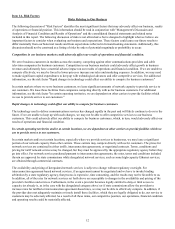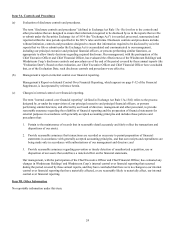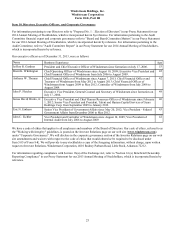Windstream 2013 Annual Report Download - page 116
Download and view the complete annual report
Please find page 116 of the 2013 Windstream annual report below. You can navigate through the pages in the report by either clicking on the pages listed below, or by using the keyword search tool below to find specific information within the annual report.
18
estimate the amount of these reductions until we can quantify the amount of traffic based on information obtained from long
distance carriers.
In 2013, we received approximately 5 percent of our revenues from state and federal USF, and any material adverse
regulatory developments with respect to these funds could adversely affect our financial and operating condition.
We receive state and federal USF revenues to support the high cost of providing affordable telecommunications services in
rural markets. Such support payments constituted approximately 5 percent of our revenues for the year ended December 31,
2013. A portion of such fees are based on relative cost and voice line counts, and we expect receipt of such fees to decline as
we continue to reduce costs and lose voice lines. Pending regulatory proceedings could, depending on the outcome, materially
reduce our USF revenues.
At the state level, Texas, which is our largest state USF provider, continues to review its USF funding mechanism, and any
adverse developments could significantly affect our USF revenues. Texas state USF revenues were $78.2 million in 2013.
We are required to make contributions to state and federal USF programs each year. Most state and federal regulations allow us
to recover these contributions by including a surcharge on our customers' bills. If state and/or federal regulations change, and
we become ineligible to receive support, such support is reduced, or we become unable to recover the amounts we contribute to
the state and federal USF programs from our customers, our results of operations and financial condition would be directly and
adversely affected.
We may be unable to fully realize expected benefits from our recent acquisitions.
We expect to achieve substantial synergies, cost savings and growth opportunities as a result of our recent acquisitions. If we
are unable to successfully integrate acquired businesses, or integrate them in a timely fashion, we may face material adverse
effects including, but not limited to:
• diversion of management's attention to and potential disruption of our ongoing businesses;
• customer losses;
• the loss of quality employees from the acquired companies;
• adverse developments in vendor relationships;
• declines in our results of operations and financial condition; and
• a decline in the market price of our common stock.
Even if we successfully integrate these businesses, there can be no assurance that these integrations will result in the realization
of the full benefit of the anticipated synergies, cost savings or growth opportunities or that these benefits will be realized within
the expected time frames.
Weak economic conditions may decrease demand for our services.
We could be affected by economic conditions and downturns in the economy, especially in regards to our business customers.
Downturns in the economy in the markets we serve could cause our existing customers to reduce their purchases of our services
and make it difficult for us to obtain new customers.
Our relationships with other communications companies are material to our operations and their financial difficulties may
adversely affect us.
We originate and terminate calls for long distance and other voice carriers over our network in exchange for access charges.
These access charges represent a significant portion of our revenues. Additionally, we are making significant capital
investments to deploy fiber-to-the-tower and other network services for wireless companies in return for long-term revenue
generating contracts. If these carriers go bankrupt or experience substantial financial difficulties and we are unable to timely
collect payments from them, it may have a negative effect on our results of operations and financial condition.
























